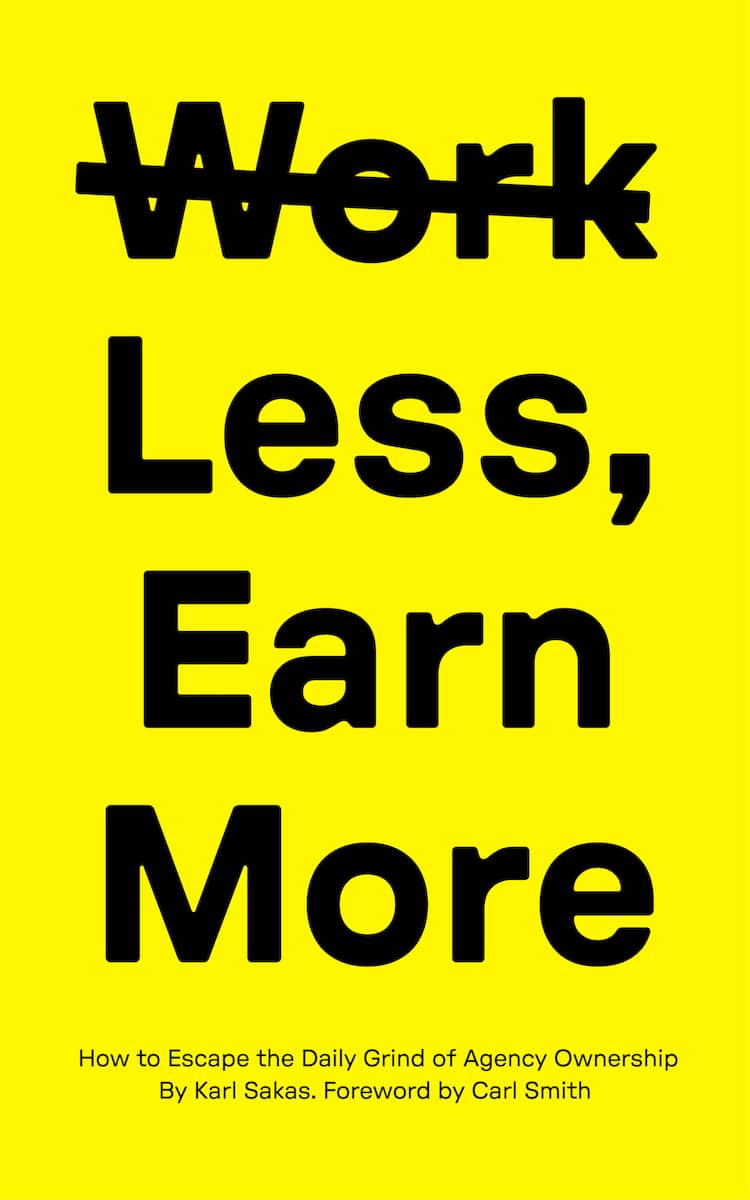Want to improve your agency’s performance, but don’t love tracking metrics? You’re not alone! What if I told you that you could start tracking your agency’s productivity and performance using just one number?
You can! The #1 metric is what I call “Rev/FTE” (“rev[enue] per FTE”), also known as “per-capita billables”—but it might not be what you think it is.
Rev/FTE is your agency’s average annual services revenue per full-time equivalent team member. This isn’t quite the same as “Annual Employee Billables” (a per-person target)—because Rev/FTE is an annual average, not an individual target. Importantly, it excludes Cost of Goods Sold (CoGS) and other “pass-through” items—including marked-up media buys, printing, and project-based contractors.
As an agency owner, you want to measure your team’s overall productivity (billable revenue relative to the size of the team) and Rev/FTE provides a consistent way to track productivity over time, even as your agency team and services change. (And keep in mind that per-capita billables gives you a starting point, not an ending point.)
Using this Rev/FTE number, you’ll be able to compare your agency to industry benchmarks and what levers will improve your future performance. I use the Rev/FTE number as the primary KPI in my consulting work, because it measures the composite impact of each agency implementing my strategic advice.
Calculating Rev/FTE can seem complicated at first, so I’ve broken-out the process in an understandable step-by-step way. Once you get a hang of it, it’ll be an easy single KPI to track—and your profit margins will be happier, too.
There are three key parts to Rev/FTE process:
- Understand how to calculate Rev/FTE.
- Know benchmarks to measure progress.
- Use levers to improve the numbers behind Rev/FTE.
Let’s dive in!
Part #1: How to calculate Rev/FTE
Here’s my step-by-step process to calculate Rev/FTE. Once you gather the inputs, the process will go much faster next time; I can calculate Rev/FTE in less than 30 seconds.
1) Calculate your services revenue (Rev)
- Pick a 12-month period—either the last calendar year, or the last 12 months. If you pick a shorter period, aim for a minimum of 3+ months of data to smooth-out monthly variations. If that’s not possible, you’ll need to multiply the number to “annualize” it to 12 months.
- Open your accounting software and run a Profit & Loss (P&L) report for that 12-month span.
- Take your annual revenue (aka “Income” or “Total Income” or “Revenue” or “Gross Revenue”) and subtract pass-through expenses that are immediately re-billed to clients (e.g., media buys, printing, promotional products, project-specific contractor payments). These are often listed under “Cost of Goods Sold” (CoGS). Also subtract fees that didn’t come from providing services to clients (e.g., affiliate fees, referral fees, and markup on pass-through expenses). Bottom line: you’re subtracting any revenue that’s not specific to the size of your team.
- The resulting number is your [annual] services revenue meaning revenue generated by your team for billable services. In your accounting software, it might already exist as “Gross Profit” or “Net Revenues.”
- NOTE: While you’re running your P&L and doing this calculation, it may spark other offshoots questions like, “How much should we be spending on sales?” or “How much should be spending on self-marketing?” This is normal and worth investigating as part of the larger snapshot of your agency.
2) Calculate your FTE count
We’re going to convert your team to a single Full-Time Equivalent (FTE) number. Our goal is to calculate productivity relative to the size of your team but also relative to how much time people worked. For instance, you’d expect less productivity from a part-time team member than a full-time team member.
Pull a list of team members, including contractors who do work every (or almost every) week, keeping the following in mind:
- If someone works full-time, they count as 1.0 FTE.
- If someone works half-time (e.g., 20 hours in a 40-hour workweek), they’re 0.5.
- Be sure to include any contractors who do work on a regular basis (e.g., a contractor who works 10 hours every week would be 0.25 FTE, but you wouldn’t count a contractor who’s paid for a single brief project).
- If the team shifted during the 12-month period you’re considering, you’ll need to create a weighted-average FTE figure for the period.
3) Calculate your Rev/FTE
Now that you have annual services revenue (aka “Rev”) and the full-time equivalent count (aka “FTE”), you can calculate Rev/FTE! Take the services revenue figure and divide it by the FTE figure. This is your Rev/FTE.
- If you’re considering a shorter period than 12 months, multiply it to “annualize” the number. For instance, double it if it’s six months of data, or quadruple it if it’s three months of data. (These are less precise than a full year, but sometimes you need to work from less data.)
- For most agencies, Rev/FTE is somewhere between $100,000 and $400,000. This is your annual services revenue, averaged across your entire team.
- If you’re outside the U.S., calculate your Rev/FTE in your local currency.
Now, let’s see how your Rev/FTE compares to industry benchmarks…
Part #2: Compare your agency to industry benchmarks
Each agency is unique—but I have some industry benchmarks for Rev/FTE. Specialist agencies should have a higher Rev/FTE than generalist agencies because specialists should be charging premium prices. Note that everything below is listed in U.S. dollars.
- If you’re a generalist, your [annual] Rev/FTE should be $180,000 or higher.
- If you’re a specialist, your [annual] Rev/FTE should be $250,000 or higher.
What if you’re above or below the benchmark?
- If your Rev/FTE is above either number, you’re doing well. And if it’s approaching $300,000 or higher, you’re doing really well.
- If your Rev/FTE is below $120,000, your agency is at risk of going out of business because there’s minimal room for profits after you pay your team. (One exception: If you’re in a country with a very low cost of living.)
It’s important to recalculate your Rev/FTE over different periods of time and ask yourself, “Is my Rev/FTE going up, going down, or a mix?” Ideally it’s going up over time, due to premium pricing and keeping up with inflation.
Now that you know your Rev/FTE, let’s look at two primary levers to improve your Rev/FTE numbers…
Part #3: Use “levers” to improve the numbers behind your Rev/FTE
There are just two levers to improve Rev/FTE:
- Increase revenue without increasing your team, and/or
- Decrease the size of your team, while delivering the same level of revenue.
An example of when you’d want to decrease the size of your team is if a [primarily] billable team member is billing less than you’re paying them—for instance, you’re paying them $125,000 a year, they’re supposed to bill $250,000 a year, yet they’re consistently billing just $100,000 a year.
Hiring and team management practices are key to improve your Rev/FTE. The following points will help get you there:
- As you grow revenue, don’t hire immediately; try to generate revenue with your existing team.
- Don’t immediately jump to hire a salesperson (or multiple salespeople) because they increase the FTE count without immediately generating revenue which means your Rev/FTE goes down at least initially.
- Think strategically about hiring. Sometimes a moderately billable team member (e.g., a project manager or a team lead) is a good investment if they enable you to hire other team members who are highly billable.
- Don’t tolerate low billable performance from a new team member, since they’re hurting your services revenue in the future. This is a primary reason to have a new-hire ramp-up plan.
- If you hire ahead of demand, be sure your sales pipeline is ready to put people to work quickly.
Real World Example #1: Add $1.3MM in Profits
Sometimes, it helps to see a real-life example of using Rev/FTE, as you weigh how to improve your performance. Here’s an example:
- I received a sales inquiry from a generalist agency in Tennessee with 40 people, all working full-time.
- Their recent 12-month services revenue was $4M, which meant they have $100K in Rev/FTE—when it really should have been $150K+, based on their specific situation.
- I proposed strategic advice to get them from where they were—at $100K to $150K in Rev/FTE—multiplied by the 40 people they had.
- This would increase their revenue by $2 million a year—with most of that extra $2MM being profit because it’s revenue without having to hire new team members. And over time, they could get this to $180K in Rev/FTE.
- As they grew, they’d need to make a few hires, so let’s imagine that’s $1.3MM in net profits before taxes. That’s almost $1MM in after-tax profits, by fixing the inputs to Rev/FTE. Not bad, right?
Let’s look at one more Rev/FTE example.
Real World Example #2: More Profitable to Lose a Sales Opp
I was advising a client on a big sales opportunity. If the deal closed, she’d more than triple his revenue overnight—and she’d need to 3X her team. High-risk, high-reward.
As the deal became tenuous, I knew she was disappointed it might fall through—she’d been excited about the increase in total annual profits. The prospect was considering a smaller strategy-only deal.
I did some new Rev/FTE calculations—and the results were reassuring. The current year’s Rev/FTE was $230K.
- Option 1—Win the Full Deal: If the full deal did close, revenue would go up dramatically… but so would her FTE count. By my projections, Rev/FTE would drop 15% to $196K. Absolute profits would be up… but it wouldn’t be efficient growth. And now they’d have a serious Client Concentration problem.
- Option 2—Lose the Big Deal: If the deal didn’t close, she planned to terminate a couple poor-fit team members. Next year’s revenue projection would stay the same—which mean Rev/FTE rose 18% to $272K.
- Option 3—Win a Smaller Deal: If the prospect did a strategy-only deal, revenue would rise significantly… with only a small increase in FTE count. Rev/FTE would be $307K.
I shared the results with my client. She acknowledged that winning the full deal would be nice… but now she saw that losing wasn’t a bad thing. And a smaller (yet more profitable) deal might be the best outcome of all—higher profits with less stress would contribute to “Work Less, Earn More.”
Applying the “Rev/FTE” KPI at your agency
Using Rev/FTE helps you set revenue goals, make hiring decisions, and more. It’s a perfect first step into a better, more profitable agency moving forward.
Any agency owner can benefit from implementing Rev/FTE as their core KPI. Yes, you’ll want to track other metrics, too—but it helps to distill things to a single number.
QUESTION: After calculating your agency’s current Rev/FTE, how far are you from the benchmark?
Originally published in January 2021, and updated with our latest Rev/FTE benchmarks in January 2022.


